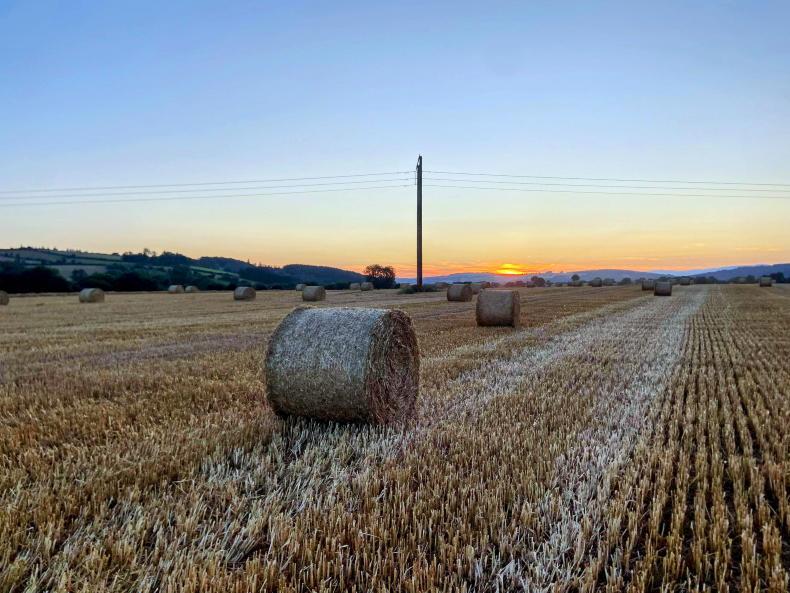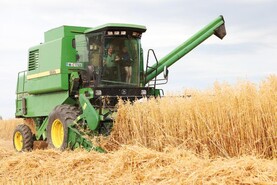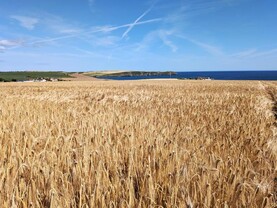Villierstown, Co Waterford
There has been a lot of action in Waterford, with around 25 people involved on Sunday between cutting, drawing grain, raking, baling, and clearing fields of bales.
Fortunately, Pádraig managed to finish his winter barley. He is happy with how it performed overall, but he says that while he is cutting decent crops in great weather, it is the price that is disappointing this year.
One field of Integral yielded 3.5t/ac at 14% moisture, but another yielded 4.2t/ac at the same moisture level. The hectolitre weight was between 63.5 and 66.7.
Pádraig says the crop looked excellent.
The better-yielding crop was after beans, while the other crop was a second cereal.
The Belfry and SY Canyon barley is estimated to have yielded 3.8t/ac, with a KPH of 66.7, but these loads have not been delivered yet. All of the straw has been baled, with the last sward baled just as the first drops of rain fell on Sunday evening.
There was an average of 11 bales per acre. There has been an increased demand for straw this year for Pádraig from local farmers.
He also had a close call with the combine.
Ash
He could smell smoke, and when he checked, there was chaff on the diesel tank near the engine which was smouldering and turning to ash. Luckily, there was no flame. This happened despite Pádraig cleaning down his combine between each field and washing out the radiators each day.
The winter oats are ready to go this week despite some green plants in the tramlines and under trees.
The spring barley is probably two weeks away, and the wheat is similar or even further away.
The spring beans still look good, with lots of pods and three or four beans in each pod, but a lot of chocolate spot has come into the crop. However, Pádraig is not worried as he has kept it at bay for as long as he could. The tops of the plants are beginning to turn brown now.
Dunsany, Co Meath
The hot conditions brought crops in very quickly in Meath last week, with the harvest beginning on David’s farm on 8 July. He says that harvest conditions have been excellent and the farm has made the most of the weather.
The Belfry winter barley was the first to be cut but other varieties were not far behind. Grain yields are coming in between 3.7 and 4.2t/ac, with hybrid six-row varieties outperforming two-rows.
However, the hectolitre weight of the two-row varieties is coming in at 62 to 69KPH, compared to 55 to 61KPH for the six-row varieties.
The moisture content is very low, between 12.2% and 15.5%. The grain is also very hot at between 30°C and 35°C, and so requires constant cooling with fans to avoid moisture spikes.
Hot conditions
Straw is slow to bale as it was quite damp behind the combine and took longer than expected to dry in the hot conditions.
David says there is a notable difference in the quality of the straw between varieties, with some breaking down very easily post-harvest. Any straw that is baled is of very high quality and dry, at 11% to 12% moisture content.
The winter oats are coming in quickly too and he expects to begin harvesting them early next week. They will be followed quite closely by the winter oilseed rape. Pod-Stik has been applied at 1l/ha so the oilseed rape crops should be safe if there is broken weather when ripe and harvest is delayed.
David says the farmyard is busy keeping barley moving through the grain dryer and into stores, ensuring no backlogs occur once other crops start to come in, especially as they may require drying.
The spring crops look good on the farm. He says the harvest won’t be long creeping up for these too.
Mountrath, Co Laois
The harvest kicked off for Stephen over the weekend with a small bit of contracting. He ran into a problem on Saturday afternoon with the barley refusing to go into the combine.
The barley was cut and brought to the neck of the combine, but the grain was falling out of the ears very easily and blocking the intake.
Stephen reckons this was because the crop was very ripe and extremely dry. He says there was nothing he could do except wait until 10pm on Saturday to continue with the harvesting.
His own harvest will begin with winter oats in about 10 days’ time.
The grain is turning quickly but the straw is still very green, so he thinks it will need this time to ensure the crop is easy to cut and the green straw has time to mature and dry out.
Flag leaf
The winter wheat looks very good and is holding onto its green colour very well. There is still some life in the flag leaf and Stephen says it is probably about three weeks away from harvest.
He is happy with his spring barley. It looks very good, especially considering the stress it was under earlier this year, and he hopes to be harvesting it in the first couple of weeks of August.
Stephen thinks that the winter wheat and spring barley will be the stars of the show in 2025.
The late-sown spring oats are now coming under stress, with some yellowing leaves.
However, there is a good biomass to the crop.
No more sprays will be applied to the crop.
The leaves of the spring beans curled up in the hot weather, but Stephen does not think it has affected them too much, especially with rain falling this week.
However, the winter beans have some pods that are starting to split.
There are huge beans in the pods, and there is some chocolate spot in the crop too.






 This is a subscriber-only article
This is a subscriber-only article










SHARING OPTIONS: